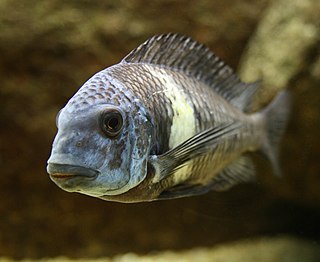
Tropheus is a small genus of six species of cichlids endemic to Lake Tanganyika in East Africa. The genus is widespread across all regions of Lake Tanganyika, from Burundi in the north to Zambia in the south. Males and females are relatively similar, but do display obvious sexual dimorphism. Males attain a somewhat larger size. All species maternally mouthbrood their eggs and fry, and this characteristic provides their Latin name. Tropheus comes from the Greek trophos, which means "to nurture". The genus is fished lightly by the local population, but has never become a staple food fish due to its relatively small size and its habitat, which enables it to dart between rocks when threatened.

The Réunion night heron is an extinct species of heron formerly occurring on the Mascarene island of Réunion.
The Réunion pink pigeon is an extinct species of pigeon that formerly lived on the Mascarene island of Réunion. It is known from the description of a rusty-red pigeon given by Dubois in 1674 and a single subfossil humerus that agrees with that of the pink pigeon of Mauritius in generic characteristics, except being slightly longer. Also, Dubois' reference to the bill being red at the base and the eyes being surrounded by a red ring suggest that this species was closely allied to the Mauritus taxon. Dubois' description was as follows:
wild pigeons, everywhere full with them, some with slaty-coloured feathering [Alectroenas?], the others russet-red [N. duboisi]. They are a little larger than the European pigeons, and have larger bills, red at the end close to the head, the eyes ringed with the colour of fire, like pheasants. There is a season when they are so fat that one can no longer see their cloaca [croupion]. They are very good tasting. Wood-pigeons and turtle-doves, as one sees in Europe and as good.
The Réunion kestrel is an extinct bird of prey which belongs to the falcon family. It inhabited the Mascarene island of Réunion and was part of the Western Indian Ocean radiation of kestrels.
Rhacophorus duboisi is a species of frog in the family Rhacophoridae found in China and Vietnam. Its natural habitats are subtropical or tropical moist montane forests, freshwater marshes, intermittent freshwater marshes, and heavily degraded former forests. It is threatened by habitat loss.

Tropheus duboisi, the white spotted cichlid, is a species of cichlid endemic to Lake Tanganyika. It can reach a length of 12 cm (4.7 in).
Tetraodon duboisi is a species of pufferfish endemic to the Democratic Republic of the Congo where it is known only from Stanley Pool. Some sources speculate that they are critically endangered in the wild, but that theory is difficult to verify as violence in the Democratic Republic of the Congo makes it extremely difficult to capture them for the aquarium trade and scientific research. However, there are a few Tetraodon Duboisi specimens owned by private aquarists in the United States. In terms of caring for the Tetraodon Duboisi in aquaria, this species does best in a pH of 7.0-7.5, and a GH of 10-20 grows. It grows to a length of 4 inches TL and is extremely aggressive. Best kept alone in an aquarium of 30 gallons or more.
Ropica is a genus of beetles in the family Cerambycidae, containing the following species:
Ropica fuscovariegata is a species of beetle in the family Cerambycidae. It was described by Breuning in 1939.
Ropica marmorata is a species of beetle in the family Cerambycidae. It was described by Breuning in 1939. It contains the subspecies Ropica marmorata marmorata and Ropica marmorata sarawakiana.
Ropica nigroscutellata is a species of beetle in the family Cerambycidae. It was described by Breuning in 1939.
Ropica pseudosignata is a species of beetle in the family Cerambycidae. It was described by Breuning in 1939.
Ropica biroi is a species of beetle in the family Cerambycidae. It was described by Breuning in 1953.
Ropica hayashii is a species of beetle in the family Cerambycidae. It was described by Breuning in 1958.
Ropica sechellarum is a species of beetle in the family Cerambycidae. It was described by Breuning in 1957. It contains the subspecies Ropica sechellarum interruptefasciata and Ropica sechellarum sechellarum.
Ropica signata is a species of beetle in the family Cerambycidae. It was described by Pic in 1932.
Ropica ignobilis is a species of beetle in the family Cerambycidae. It was described by Newman in 1842.
Ropica immista is a species of beetle in the family Cerambycidae. It was described by Newman in 1842.
Ropica formosana is a species of beetle in the family Cerambycidae. It was described by Bates in 1866. It contains four subspecies, Ropica formosana formosana, Ropica formosana japonica, Ropica formosana nobuoi, and Ropica formosana tokaraensis.



